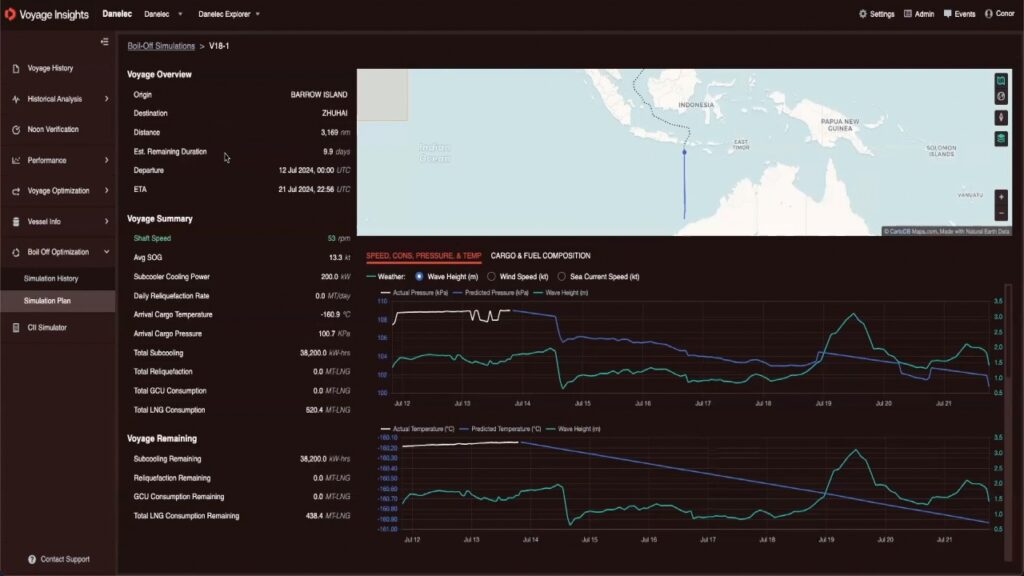Danelec Launches Groundbreaking Simulation Tool to Enhance LNG Carrier Efficiency
Danelec has introduced a cutting-edge simulation tool aimed at optimizing efficiency by improving collaboration between LNG Carrier Commercial and Operations teams. This innovative suite addresses crucial challenges within the sector by leveraging advanced simulation technologies and data analytics, fostering enhanced cooperation between charterers and vessel owners for better decision-making and negotiation outcomes. With the ability to potentially save over 100 metric tons of LNG per voyage and yield approximately $360,000 in savings per vessel annually, this tool stands to revolutionize operational practices.
LNG carrier operations face a unique set of challenges, including the need to balance various factors to satisfy charter party specifications, maintaining cargo temperature and pressure during discharge, and optimizing voyage planning amidst fluctuating weather conditions and complex routes. Danelec’s new cloud-based platform is designed to tackle these issues comprehensively, providing precise simulations and real-time performance monitoring that ensure operational efficiency and regulatory compliance.
The suite of LNG carrier voyage simulation tools from Danelec is set to transform how teams across the LNG value chain plan and execute their operations. By giving marine teams within energy corporations and vessel owners access to high-fidelity digital twins of their specific vessels and cargoes, the platform equips Commercial and Operations teams with the analytical prowess to uncover new insights related to various voyage plans and operational strategies, both before and during voyages.
Claus Borum, CTO and EVP of Ship Performance at Danelec, emphasized the power of the new simulation tool: “Rather than relying on rough estimates from spreadsheets, operators can now utilize our state-of-the-art predictive technology to enhance every voyage’s efficiency. This gives them a competitive advantage in the market while also strengthening their collaboration with commercial teams.”
By simulating expected vessel performance and providing optimized operational parameters, Danelec’s platform allows operators to plan and execute voyages more effectively. The tool offers detailed simulations that integrate route waypoints, cargo composition, vessel loading, and anticipated weather conditions, delivering actionable insights for operational improvements. Additionally, the platform supports continuous mid-voyage updates, enabling operators to adapt to changing conditions in real time—optimizing factors like reliquefaction and subcooling rates, engine modes, shaft speed, and gas combustion unit (GCU) usage.
Moreover, the platform facilitates precise measurements of vessel performance, taking into account actual weather conditions and cargo composition, which helps in early identification of potential issues. This proactive approach minimizes the risk of performance shortfalls and ensures adherence to charter party agreements. The automated data collection and reporting capabilities also simplify compliance with rigorous environmental regulations, reflecting operators’ commitment to sustainable practices.
Danelec’s solutions not only streamline operations but also promote improved collaboration between charterers and vessel owners. By enabling data-driven decision-making and providing real-time performance insights, the platform helps both parties align on charter party terms that enhance overall voyage efficiency, resulting in better outcomes for all involved stakeholders.
The enhanced insights into voyage outcomes also empower negotiations with terminals regarding arrival requirements, leading to advantageous terms and more efficient operations.
Borum concluded, “The innovative capabilities we are introducing breathe new life into the LNG carrier business model, resulting in considerable cost savings and efficiency improvements. Our holistic platform allows customers to leverage advanced predictive analytics and real-time data, facilitating informed operational decisions. It not only meets regulatory requirements but also strengthens partnerships between charterers and owners, optimizing operations and positively impacting the bottom line for all stakeholders.”




